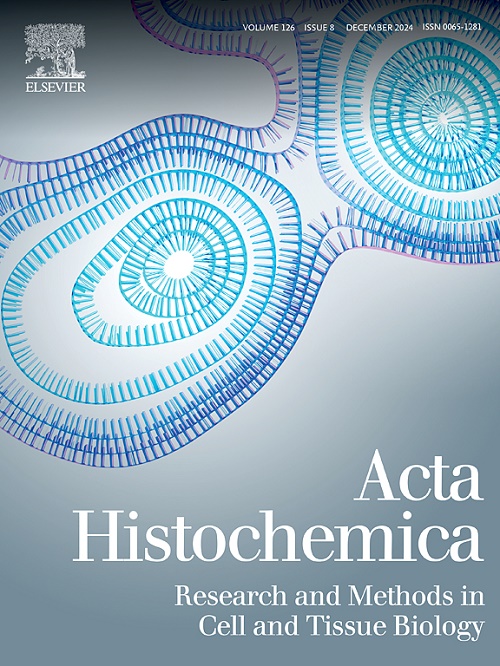Nrf2:调控胃癌细胞凋亡、铁变态反应和自噬的关键参与者
IF 2.4
4区 生物学
Q4 CELL BIOLOGY
引用次数: 0
摘要
核因子红细胞 2 相关因子-2(Nrf2)是一种特异性转录因子,它通过调节抗氧化应激相关基因的表达来维持氧化还原平衡。Nrf2 的过度激活参与了肿瘤的进展,并与大量实体瘤的化疗耐药性有关。程序性细胞死亡(PCD),如细胞凋亡、铁凋亡和自噬,在肿瘤发生和化疗敏感性中起着至关重要的作用。越来越多的证据表明,一些抗肿瘤化合物和基因可通过抑制Nrf2的表达诱导活性氧(ROS)的大量产生,从而加剧氧化应激并促进胃癌(GC)细胞的死亡,从而提高胃癌细胞对化疗诱导的PCD的敏感性。在这篇综述中,我们总结了抗肿瘤药物通过调节 Nrf2 的表达干扰 GC 细胞三种不同类型的 PCD(凋亡、铁突变和自噬)的作用,以及靶向 Nrf2 带来 PCD 和化疗敏感性的分子机制。我们有理由相信,Nrf2 是一个潜在的治疗靶点,通过药物或基因调控靶向 Nrf2 可为治疗 GC 提供一种新策略。本文章由计算机程序翻译,如有差异,请以英文原文为准。
Nrf2: A critical participant in regulation of apoptosis, ferroptosis, and autophagy in gastric cancer
Nuclear factor erythroid 2-related factor-2 (Nrf2) is a specific transcription factor that maintains redox homeostasis by regulating the expression of anti-oxidative stress-related genes. Hyperactivation of Nrf2 is involved in tumor progression and is associated with chemoresistance in a large number of solid tumors. Programmatic cell death (PCD), such as apoptosis, ferroptosis, and autophagy, plays a crucial role in tumor development and chemotherapy sensitivity. Accumulating evidence suggests that some anti-tumor compounds and genes can induce massive production of reactive oxygen species (ROS) via inhibiting Nrf2 expression, which exacerbates oxidative stress and promotes Gastric cancer (GC) cell death, thereby enhancing the sensitivity of GC cells to chemotherapy-induced PCD. In this review, we summarize the role of antitumor drugs in interfering in three different types of PCD (apoptosis, ferroptosis, and autophagy) in GC cells by modulating Nrf2 expression, as well as the molecular mechanisms through which targeting Nrf2 brings about PCD and chemosensitivity. It is reasonable to believe that Nrf2 serves as a potential therapeutic target, and targeting Nrf2 by drug or gene regulation could provide a new strategy for the treatment of GC.
求助全文
通过发布文献求助,成功后即可免费获取论文全文。
去求助
来源期刊

Acta histochemica
生物-细胞生物学
CiteScore
4.60
自引率
4.00%
发文量
107
审稿时长
23 days
期刊介绍:
Acta histochemica, a journal of structural biochemistry of cells and tissues, publishes original research articles, short communications, reviews, letters to the editor, meeting reports and abstracts of meetings. The aim of the journal is to provide a forum for the cytochemical and histochemical research community in the life sciences, including cell biology, biotechnology, neurobiology, immunobiology, pathology, pharmacology, botany, zoology and environmental and toxicological research. The journal focuses on new developments in cytochemistry and histochemistry and their applications. Manuscripts reporting on studies of living cells and tissues are particularly welcome. Understanding the complexity of cells and tissues, i.e. their biocomplexity and biodiversity, is a major goal of the journal and reports on this topic are especially encouraged. Original research articles, short communications and reviews that report on new developments in cytochemistry and histochemistry are welcomed, especially when molecular biology is combined with the use of advanced microscopical techniques including image analysis and cytometry. Letters to the editor should comment or interpret previously published articles in the journal to trigger scientific discussions. Meeting reports are considered to be very important publications in the journal because they are excellent opportunities to present state-of-the-art overviews of fields in research where the developments are fast and hard to follow. Authors of meeting reports should consult the editors before writing a report. The editorial policy of the editors and the editorial board is rapid publication. Once a manuscript is received by one of the editors, an editorial decision about acceptance, revision or rejection will be taken within a month. It is the aim of the publishers to have a manuscript published within three months after the manuscript has been accepted
 求助内容:
求助内容: 应助结果提醒方式:
应助结果提醒方式:


